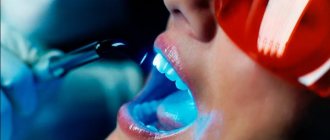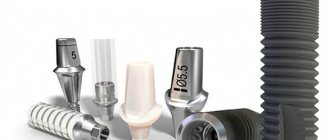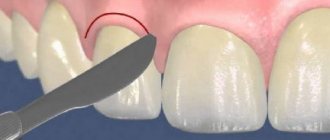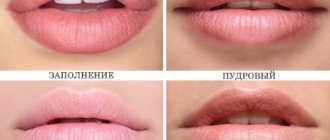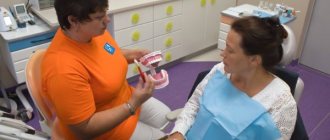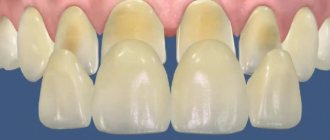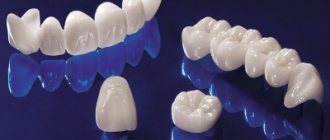7683
Fang augmentation is not only a necessary medical procedure, but also a current fashion trend among teenagers and young adults. In Russia, it became popular after the film adaptation of the famous vampire saga “Twilight”.
You can grow your fangs at any dental clinic. But before deciding on the procedure, you need to study all the features, indications and contraindications.
Indications for the procedure
- deformation and/or destruction of the crown,
- congenital anomalies of the dentition (bite defects),
- increased sensitivity of enamel,
- enamel susceptible to thinning,
- chip, crack of the crown,
- gap between the front teeth (diastema) and/or gaps between the remaining crowns (trema),
- noticeable darkening of the enamel, the presence of stains on it,
Important! Restoring anterior teeth using extensions is a more gentle and cost-effective method compared, for example, with prosthetics.
How much does it cost to restore a tooth?
The cost of the procedure is affected by:
- region;
- the reputation of the clinic, its pricing policy;
- which procedure is chosen or appropriate;
- type of material;
- size of damage;
- amount of preparatory work.
Approximate cost of teeth extensions
Tooth augmentation is a set of procedures aimed at restoring the functionality of the natural dentition.
- photopolymer restoration – 4000 rubles;
- restoration of a damaged crown using foreign polymers – 900 rubles per unit;
- fiberglass pin with installation – 2000 rubles;
- installation of veneer – 3,000 – 20,000 rubles;
- installation of lumineers – from 25,000 rubles;
- anesthesia, pads, sterile kit – 500-600 rubles.
The use of imported materials extends the life of the extended tooth, although they are more expensive. If the tooth is restored efficiently, it will serve for another 5-6 years. Therefore, the cost of such procedures is completely justified and acceptable.
For whom the procedure is contraindicated
- in case of significant damage to the crown,
- in the presence of some forms of bite deformation,
- with cystic forms of periodontitis,
- with excessive salivation, which complicates the procedure,
- for any unresolved inflammatory process in the oral cavity,
- with bruxism (grinding your teeth in your sleep),
- if you are allergic to any of the components of the restoration materials,
- with total non-compliance with oral hygiene.
Methods
Artistic restoration of fangs, like any other medical procedure, requires a complex of preparatory therapy and preventive measures. After examining the patient and carrying out an individual diagnosis, the specialist determines their number and direction.
The preparation process can be divided into two types of procedures - general preparatory and direct mandatory. The first ones are done at will or according to medical recommendations, the second ones represent a preliminary part of the overall extension process and are subject to mandatory implementation.
Depending on the condition of the oral cavity, these may be:
- professional removal of tartar and plaque removal;
- anti-caries treatment;
- making a cast of the future canine – done with the aim of optimizing the shape and maximizing the size match;
- preparation - the outer surface undergoes preliminary preparation for subsequent improved adhesion of the composite material to natural tissue. This is done with extreme caution to prevent injury to the inner layers of bone tissue.
We will tell you what to do if a piece of your tooth breaks off and when you need to see a dentist. And here you can find reviews about bleaching powder for smokers.
Next, it is advisable to consider in more detail the methods of growing fangs offered by dental clinics.
Using light-curing material
This method involves grinding down natural hard fabric to the required size, after which a composite is applied to the sawn surface, giving it the desired size and shape.
The technology is similar to the procedure for acrylic nail plate extension, only in our case everything must be extremely accurate and safe. If the patient, for any reason, is dissatisfied with the result, everything can be returned to its original position, but the condition of the tooth will be irrevocably damaged.
Restoration technology involves performing basic procedures under local anesthesia, which eliminates the risk of pain.
Stages of the procedure using light-curing material:
- removing moisture from the tooth surface;
- conditioning - the top layer of fabric is etched, artificially making it rough, which increases the adhesion force of the composite and natural fabric - phosphoric acid is used as a reagent in small quantities;
- applying a bonding layer - acts as a binder between surfaces;
- direct application of the composite layer;
- abrasive polishing and grinding with special pastes that preserve a natural and healthy shine for a long time;
- final hardening - it is achieved using the illumination technique, when under the influence of rays the material hardens quickly and efficiently.
Installation of a “vampire” crown
When choosing this option, the patient must be explained that in this situation there is no way back, and if he changes his mind, the tooth will be lost without a chance of recovery.
Preliminary measures in this case are standard and depend on individual indications and the general condition of the oral cavity.
The production and installation of a “vampire” crown uses the following technology:
- formation of a preliminary impression, with the help of which a future model of a new canine will be made in a special laboratory. Using plaster as a test material, the dental technician will make a permanent “vampire” crown on this basis;
- after preliminary fitting and adjustment of the layout, the frame layout will be sent for revision if necessary;
- until its final installation, it is necessary to first install a temporary structure to make sure that everything is fine with the fang, whether the patient has any complaints, which after 2 weeks can be replaced with a permanent one;
- Having decided on the material and method of fastening, they make a finished crown and fix it with special cement.
The following video clip is about “vampire” fangs:
Methods for building up anterior teeth
Photopolymer extension
The essence of the method is that layer by layer of polymer material is applied to the area that is chipped or drilled during the treatment of caries, which hardens when the rays of a special lamp hit it. The photopolymer is selected according to the shade of the tooth enamel, and at the end of the procedure it is ground and polished.
Application of composite materials
With this method, the extension occurs using a special filling material. In fact, it overlaps with the first type, but composites that harden on their own can be used here. Usually the previous stage is therapeutic, during which carious lesions are treated. The composite is also applied layer by layer and, if necessary, cured using a special lamp. The final part of the restoration is grinding and polishing the tooth, giving it not only a beautiful, but also a comfortable shape, so that it fully matches the bite.
On a note! The method of increasing the incisor with the help of filling materials is used mainly for the restoration of chips and enlargement of the crown of ground down teeth. May also be used in some cases of diastema and trema removal.
Extension on a pin
The procedure is suitable for people who, in addition to external tooth damage, also have internal damage, for example, extensive caries or pulpitis. There is a need for a pin in cases where the top of the tooth is destroyed almost “to zero”, that is, to the base. Here the classic extension will not be effective, because the material will have nothing to cling to. Therefore, after cleaning the root canal, a pin is inserted into it, onto which the doctor places a custom-made crown / applies the same composite material to restore the integrity of the tooth.
Carefully! Pinning is not used in pediatric dentistry. If the doctor has suggested this option to your child, it is worth consulting with another specialist about the advisability of such treatment.
Veneers (Lumineers)
This method is most often used for certain types of enamel hypoplasia, or if a person is not satisfied with the aesthetics. Its essence lies in the application of veneers and lumineers (composite plates designed to replace the outer layer of the tooth) on problem areas. Many people mistakenly believe that the only role of veneers is aesthetic and they are used only to even out the color of the enamel. However, this is not so: onlays help restore the functional area of the tooth and protect its internal tissues from the bacterial environment.
Crown installation
In more complex cases, when installing veneers or a pin is impossible, the doctor turns to a method that has been proven over the years - making a crown. This is a labor-intensive procedure involving making an impression and grinding down the adjacent teeth, since the crown will be attached to them.
On a note! Listed above are all the main methods that allow you to restore your front teeth. But the first two – photo- and composite prosthetics – still belong to extensions.
Extension on a pin
Attention! If the root is intact and healthy, then prosthetics or implantation are possible. An x-ray is taken to check his condition. Using it, a model of the crown is created on a computer with anatomical accuracy.
The next stage of restoration is a metal pin is implanted into the root, and a crown is created around it from filling material. Unlike classical implantation, the tooth root is not removed, but remains. The new crown, therefore, has double fasteners - the root itself and the pin. The pin is small in size and is selected in proportion to the size of the root and tooth. It is placed into a pre-filled root canal and a replica of the tooth is then created around it. Pins have several roles in dental restoration and treatment:
- restoration;
- strengthening teeth with removed nerves;
- building up from the base of any size;
- creating a support for the crown.
A pin is a rod-shaped structure that serves to strengthen a damaged tooth and is fixed in the dental root canals.
Pins can be made not only from metal, but also from hydrocarbon and glass fibers. The constant development of high technologies, including in dentistry, makes it possible to reconstruct teeth using modern materials that provide aesthetics, safety, functionality and durability to the installed structures and crowns. This also applies to fiberglass pins.
How does the recovery process work?
Restoration with composite materials by the direct method, that is, directly in the patient’s oral cavity, is carried out in the presence of chips and cracks, areas destroyed by carious processes. In some cases, the canals are first cleaned and processed, after which they begin to build up, accurately recreating the anatomical shape of the tooth. Among the obvious advantages of the method, we can highlight the ability to achieve the same shade of the filling material and the color of natural enamel, which is very important for the front teeth. The procedure is carried out quickly, and the result is reliable and durable.
The whole process can be divided into several main stages:
- First, the doctor and the patient select the shade of the filling material, after which the specialist carefully grinds away the defects,
- Next, the doctor isolates the tooth from saliva and “neighbors” using a rubber dam, and then treats it with a special liquid composition that hardens under the rays of a UV lamp. If the tooth is severely damaged, it may be necessary to install a pin,
- the doctor begins to recreate the shape of the crown layer by layer, illuminating each next layer with ultraviolet light. For this purpose, light-curing photopolymers are usually used,
- After the anatomical shape has been completely restored, the dentist grinds and polishes the crown, coats it with fluoride varnish and a special protective compound.
The restoration is carried out in one visit, and upon completion of all the above-described manipulations, the patient leaves the dentist’s office with a new beautiful smile. In some cases, up to 6 damaged crowns can be restored in one session. On average, working on one tooth takes about 30-45 minutes, but it all depends on the complexity of each individual case.
Possible complications after the procedure
Even if the procedure was successful and all the specialist’s actions were performed as correctly as possible, it is impossible to completely insure against the following consequences:
- the appearance of a hole (perforation) in the root zone;
- swelling of the gum area in the place where the manipulation was performed;
- root cyst or granuloma;
- pain of varying degrees of intensity at the site of pressure on the installed element along with the coronal part.
You will find in our article a video on how to use dental floss correctly. And here you will find out why enamel varnish is needed.
At the following address: https://dentist-pro.ru/krasota-i-uxod/sredstva/zubnye-shhetki/kak-gramotno-vybrat-elektricheskuyu.html you will find instructions on how to choose an electric toothbrush for an adult.
Service life of restoration materials
If the restoration was carried out by a qualified specialist and in compliance with technology, then the service life of the restored units, depending on the method of execution, can reach 10-15 years or more. For example, an incisor restored with filling material will function fully for 7-10 years. True, it will be necessary to polish the material, since composites become porous and plaque will settle on them.
Are there any disadvantages to the extension procedure?
Of course, no dental procedure is without its downsides. And although extensions on a pin offer great opportunities for restoring damaged teeth, it also has its drawbacks. For example, in rare cases, installing a pin further destroys the tooth. If the doctor makes a mistake in treatment, caries may develop. Finally, the metal raw material for the rod can be damaged by corrosion.
Sometimes pins destroy teeth even more
In some cases, in order to subsequently remove the pin, the entire tooth must be removed. An allergic reaction is another potential disadvantage of the procedure. And, what is most likely, after a certain period of time (depending on your luck), the walls of the tooth become thinner and it collapses. That is, a pin is not a guarantee that the tooth will always be in this form, and no further treatment or prosthetics will be required.
After restoration, teeth will still have to be treated or removed someday
How to build up dental bone tissue at home
Only with us: Enter before 31.03.
2020 promo code bonus2020 in the coupon field when placing your order and get a 25% discount on everything!
Further development of periodontal pathology leads to bone recession, which is fraught with atrophy.
Periodontitis is the gradual destruction and change of the connective tissue that holds the tooth in the jaw bone. Therefore, at the first symptoms of gum recession, treatment must be started immediately.
What is the danger of gum recession and gum augmentation methods?
Gum augmentation is necessary when the roots of the teeth are exposed. A decrease in the volume of gum tissue can be caused by various reasons, for example, an incorrect bite. To restore the volume of soft gum tissue, surgical methods and herbal folk treatment are used.
Causes of gum recession
With some periodontal diseases, a decrease in the mass of gum tissue occurs - recession. In addition to aesthetic dissonance, this pathological process leads to a number of problems, including the loss of healthy teeth. Pathological changes in gum tissue may appear around one or more teeth.
Gum recession is an insidious disease that is not felt at all. Raising tissue levels can occur over a long period of time and go unnoticed. There are no pain symptoms in this pathology, with the exception of a reaction to temperature changes in food or when using a toothbrush. Some patients consider recession to be a consequence of age-related changes in the body.
Detachment of the gum edge can be caused by several reasons:
- anatomical features of the jaw structure;
- various forms of periodontal disease;
- removal or loss of teeth;
- poor quality oral care;
- genetic predisposition;
- age-related changes in the body;
- bad habits: smoking, addiction to seeds.
With the loss of dentition, a change occurs in the structures of the gum and dental tissue due to a lack of chewing load, as a result of which these tissues atrophy and decrease in volume.
How does poor oral hygiene contribute to the development of recession? When plaque accumulates on the teeth, pathogenic bacteria multiply, which provoke inflammatory foci in the mucous membranes. As a result of bacterial activity, the mucous membrane swells, turns red and becomes inflamed. This leads to the development of periodontal pathology, as a result of which pathological processes begin in the gums.
When inflammation occurs, gum pockets form, in which tiny particles of food remain - food for an army of bacteria. This stage of the disease is called gingivitis.
In advanced forms of gingivitis, plaque hardens, further aggravating the pathological process. Next, pathological processes occur in the periodontium, which connects the bone to the tooth.
In advanced forms of periodontitis, healthy teeth fall out.
Further development of periodontal pathology leads to bone recession, which is fraught with atrophy. Periodontitis is the gradual destruction and change of the connective tissue that holds the tooth in the jaw bone. Therefore, at the first symptoms of gum recession, treatment must be started immediately.
Symptoms of a recession
This disease has both general and specific symptoms.
Common symptoms include:
- reduction in the volume of soft gum tissue;
- exposure of the tooth root;
- tooth reaction to hot/cold;
- development of root caries.
Symptoms of traumatic recession include:
- mechanical damage to the dentition;
- reduction no more than 3 mm;
- thickening in the form of a roller;
- absence of inflammatory process;
- absence of dental plaque as a factor in the appearance of recession;
- increased sensitivity to temperature changes.
Symptoms of a symptomatic recession include:
- localization in one tooth;
- presence of dental plaque;
- bleeding of the mucous membrane;
- inflammatory processes;
- change in color of the mucous membrane;
- presence of periodontal pockets;
- loose teeth;
- gum suppuration;
- generalized recession.
Symptoms of physiological recession include:
- age-related changes in patients aged 60 years and above;
- damage to the upper and lower gums simultaneously;
- large rise above the root of the teeth;
- absence of inflammation;
- There is no loose teeth.
Degrees of recession
Reduction in the volume of gum tissue develops in several directions, depending on the location in the oral cavity, the severity of the disease and the causes of its occurrence.
Recessions are distinguished by the scale of their spread:
- local - affects the mucous membrane around one tooth;
- generalized - affects the mucous membrane around the dentition.
There are three degrees of gum atrophy:
- mild form - tissue lifting by 3 mm;
- medium - tissue lifting by 5 mm;
- heavy - tissue lifting by more than 5 mm.
Recessions vary according to their causes:
- traumatic - prolonged mechanical impact on the mucous membrane;
- symptomatic - inflammatory processes in the oral cavity, poor hygiene;
- physiological - age-related changes in tissues.
The insidiousness of recession lies in the presence of a latent form of pathology, when the disease occurs inside the mucous membrane and is invisible to the naked eye. It is possible to identify a hidden form of pathology only with the help of probing.
When is gum augmentation required?
In what cases is gum tissue augmentation (regeneration) recommended? This procedure is performed for medicinal and aesthetic purposes.
Regeneration for medicinal purposes:
- for periodontitis/periodontal disease;
- for prosthetics/implantation;
- with an incorrect bite.
For therapeutic purposes, correction of the soft tissue contour and gum augmentation preserves teeth from the occurrence of root caries. In advanced forms of periodontal disease, gum pockets cannot be corrected; it is possible to restore sufficient gum volume only through regeneration. After a successful operation, the sensitivity of teeth to the aggressive effects of cold/hot temperatures also disappears.
For aesthetic purposes:
- with irregular gum contour;
- with mechanical injury to gum tissue;
- with pathology of soft tissues as a result of bad habits.
Aesthetic plastic surgery forms the correct contour of the gum tissue, resulting in a person gaining an attractive smile.
Surgical method of intervention
The method of operative surgery depends on the degree of soft tissue deficiency. If the cause of the recession is a lack or atrophy of bone tissue, the bone mass is first built up. There are several methods for this:
- block replanting;
- regeneration itself;
- sinus lift;
- plastic surgery.
How does the surgical gum augmentation procedure take place? During the operation, an autograft can be used - a piece of the mucous membrane or an artificial biological material that acts as a catalyst for tissue growth.
It is preferable to use artificial biomaterial: in this case, the surgeon performs an operation to implant donor tissue. In the case of using an autograft, the patient is forced to undergo a double surgical intervention - during the collection of donor tissue and during implantation.
Also, after taking the donor site of the mucosa, postoperative scars are formed that will remain forever. As with any operation, after removal of a section of mucous membrane, foci of inflammatory processes may arise that require additional treatment.
Is non-operative treatment of the disease possible? In this case, collagen is used.
However, the method of using collagen is justified only at the initial stage of pathology development, when the contour has risen by no more than 3 mm and the roots of the teeth have not opened.
Also, this method is justified only in the symptomatic form of the pathology with the presence of inflammatory formations. This method involves the introduction of collagen into the gum area.
Self-treatment methods
Is it possible to grow gums with periodontal disease? You can restore your gums to health at home. If you notice an alarming symptom of exposed tooth roots, take action.
For treatment you will need:
- soft toothbrush;
- pharmacy ointment for gums;
- periodontal toothpaste;
- herbal decoctions - chamomile, sage, oak, nettle;
- sea buckthorn/olive oil.
A hard toothbrush should be replaced with a soft one so that the bristles do not injure the soft gum tissue. When cleaning your teeth, the movements of the brush should be smooth, directed from top to bottom. During the day, rinse your mouth with decoctions of medicinal plants, and after cleaning your teeth in the evening, do a light massage of your gums with oil. To do this, saturate a cotton swab with oil and massage the gum tissue in a circular motion.
Constant massage of the gums activates the growth of soft tissue. Massaging your gums with soda paste is of great benefit. To do this, pour a handful of soda into a container and add a little water - you get a thick paste. Dip your finger into the mixture and massage your gums in gentle circular motions.
Soda helps:
- restore the alkaline environment in the oral cavity;
- destroy the activity of putrefactive bacteria;
- restore blood circulation in the vessels;
- restore the natural mass of gum tissue.
To prevent the development of destructive processes in the gums and restore tissue structure, take vitamins D, B9, C.
Preventing gum disease
Gum growth is a complex process. Preventing the development of pathology is easier than treating it. Therefore, careful attention to the health of the oral mucosa is a guarantee of preventing the development of the disease.
Benefits for gum health:
- nutritious, varied diet;
- chewing hard raw vegetables - carrots, beets;
- adequate intake of vitamin C;
- taking care of strengthening the immune system;
- strengthening the nervous system, lack of stress;
- clothing for the season - avoid hypothermia;
- timely treatment of caries;
- careful oral hygiene;
- preventive rinse with herbal mixtures.
Redness of the mucous membrane
Remember that inflammatory processes in the mucous membrane do not go away without leaving a trace; they can lead to diseases such as gingivitis and periodontal inflammation.
Minor redness of the mucous membrane can be eliminated by rinsing with herbal infusion: a pinch of any herb with an anti-inflammatory effect (chamomile, sage, St. John's wort) is brewed in a cup of boiling water.
The infusion is filtered and used for warm rinsing.
Medications can also be used for rinsing and treatment:
- hydrogen peroxide;
- furatsilin solution;
- calendula tincture;
- chlorhexine;
- Asepta ointment;
- Cholisal ointment;
- Kamistad ointment.
A solution of hydrogen peroxide is prepared as follows: a teaspoon is diluted in a quarter glass of water. Furacilin is dissolved in warm water (2 tablets per glass). Rinse your mouth with these solutions every hour until relief occurs.
Ointments are applied alternating with rinsing with herbal infusions. Cholisal is recommended for use by young children due to the absence of aggressive components in the composition. The ointment destroys microbes, soothes pain and relieves swelling of the mucous membrane.
Asept ointment contains propolis, which has an antimicrobial and regenerating effect. The effectiveness of the drug is also due to the content of the antibiotic Metronidazole.
Kamistad ointment contains chamomile extract and lidocaine. This product has a strong analgesic effect; after use, the tongue and mucous membranes become numb.
Bleeding
If your gums are bleeding, you should replace your hard brush with a soft one and purchase anti-inflammatory toothpaste. Rinsing with soda solution, herbal infusions and an aqueous solution of hydrogen peroxide is useful.
Also in case of bleeding it is necessary:
- exclude hot/cold foods from the diet;
- exclude solid foods that injure the mucous membrane.
Remember that bleeding is a path to pathological changes in the mucous membrane, gum deformation and tooth loss.
Inflammation
For frequent inflammatory processes in the mucous membrane, the following procedures are used:
- green tea with mint (herbs in equal proportions);
- sea salt (a pinch per cup of warm water);
- chewing raw ginger root – 12-15 minutes is enough;
- massage with sea buckthorn and peach oil (in equal parts).
For massage, you need to moisten the bandage in oil and gently rub the gums in a circular motion. At the same time, avoid touching the surface of the teeth with the bandage to avoid staining the enamel orange.
Remember that chronic ailments can also provoke recession of gum tissue. Therefore, timely treatment will help avoid unpleasant consequences. Incorrectly selected or installed orthopedic structures also contribute to the development of gum pathology, so at the first symptoms, take care of yourself - visit a doctor and change the design.
Related links:
How the structure of bone tissue is related to the function it performs, What is a decrease in the bone tissue of teeth, Metal accumulates in bone tissue, Bone tissue with captions,
Only with us: Enter promotional code bonus2020 in the coupon field when placing an order before March 31, 2020 and receive a 25% discount on everything!
Source: https://zdorovie-ok.ru/kak-narastit-kostnuyu-tkan-zubov-v-domashnih-usloviyah/
Advantages and disadvantages of artistic restoration
There are many benefits to the extension procedure. First of all, this is safety. Thus, teeth are restored even in children. Despite the fact that they are dairy products, they are often preserved. In this case inlays are installed for children , but pins, crowns and veneers are not suitable.
Thanks to modern technologies, tooth extension is carried out even if there is a small fragment left in its place. At the same time, the extended part will be durable and natural in appearance.
The disadvantages include high cost. Also, to ensure the safety of the restored area, it is necessary to wear a mouthguard while sleeping.
